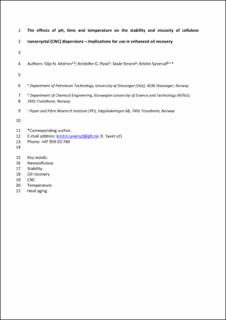| dc.contributor.author | Molnes, Silje | |
| dc.contributor.author | Paso, Kristofer Gunnar | |
| dc.contributor.author | Strand, Skule | |
| dc.contributor.author | Syverud, Kristin | |
| dc.date.accessioned | 2020-03-19T15:58:02Z | |
| dc.date.available | 2020-03-19T15:58:02Z | |
| dc.date.created | 2017-08-16T09:27:16Z | |
| dc.date.issued | 2017-08 | |
| dc.identifier.citation | Molnes, S.N., Paso, K.G., Strand, S. et al. (2017) The effects of pH, time and temperature on the stability and viscosity of cellulose nanocrystal (CNC) dispersions: implications for use in enhanced oil recovery. Cellulose, 24(10), 4479–4491 | en_US |
| dc.identifier.issn | 0969-0239 | |
| dc.identifier.uri | https://hdl.handle.net/11250/2647640 | |
| dc.description | This is a post-peer-review, pre-copyedit version of an article published in Cellulose. The final authenticated version is available online at: http://dx.doi.org/10.1007/s10570-013-9871-0. | en_US |
| dc.description.abstract | Cellulose nanocrystals (CNC) are currently being investigated as potential additives for enhanced oil recovery (EOR). Presented in this paper is a study investigating the effects of different physical and chemical environments that low concentration CNC dispersions may be subjected to at oil reservoir conditions. Different concentrations of CNC dispersed in de-ionized water and in a 1000 ppm NaCl brine were subjected to variations in pH and temperature, and the results showed that the dispersions remained stable in the pH range expected in oil reservoirs (between 5 and 9). Stable dispersions were also observed when heated to temperatures ranging from 50 to 90 °C. At extended heat aging at 90 and 120 °C for seven days; beginning degradation was observed for both types of CNC dispersions; with viscosity increase and pH decrease as the most important indicators. CNC dispersed in 1000 ppm NaCl brine was generally more heat tolerant than the CNC dispersed in de-ionized water. The increase in viscosity during heat aging can be very interesting for EOR applications. A fluid that increases its viscosity with heat and time will be easier to inject due to a low initial viscosity, and when the viscosity increases in the porous reservoir, the effect can be a stable waterfront and less viscous fingering, which again can lead to increased sweep efficiency and better oil recovery. | en_US |
| dc.language.iso | eng | en_US |
| dc.publisher | Springer International Publishing | en_US |
| dc.subject | cellulose | en_US |
| dc.subject | EOR | en_US |
| dc.subject | enhanced oil recovery | en_US |
| dc.title | The effects of pH, time and temperature on the stability and viscosity of cellulose nanocrystal (CNC) dispersions: implications for use in enhanced oil recovery | en_US |
| dc.type | Journal article | en_US |
| dc.type | Peer reviewed | en_US |
| dc.description.version | acceptedVersion | en_US |
| dc.rights.holder | (C) 2017 Springer | en_US |
| dc.subject.nsi | VDP::Mathematics and natural science: 400::Basic biosciences: 470::Biochemistry: 476 | en_US |
| dc.subject.nsi | VDP::Mathematics and natural science: 400::Chemistry: 440 | en_US |
| dc.subject.nsi | VDP::Technology: 500::Rock and petroleum disciplines: 510::Petroleum engineering: 512 | en_US |
| dc.source.pagenumber | 4479–4491 | en_US |
| dc.source.volume | 24 | en_US |
| dc.source.journal | Cellulose | en_US |
| dc.source.issue | 10 | en_US |
| dc.identifier.doi | 10.1007/s10570-017-1437-0 | |
| dc.identifier.cristin | 1486518 | |
| cristin.unitcode | 217,8,6,0 | |
| cristin.unitname | Institutt for petroleumsteknologi | |
| cristin.ispublished | false | |
| cristin.fulltext | postprint | |
| cristin.qualitycode | 1 | |
